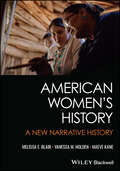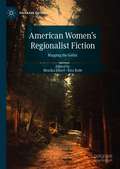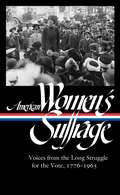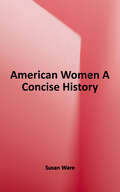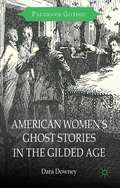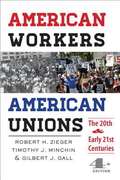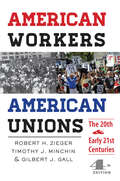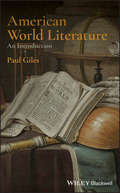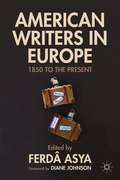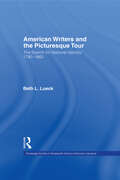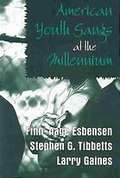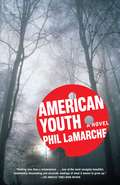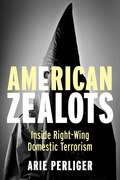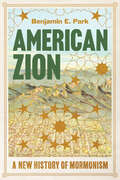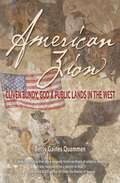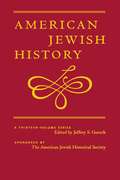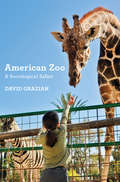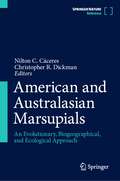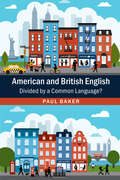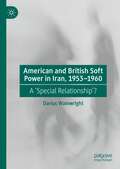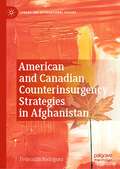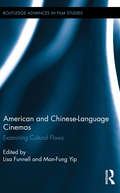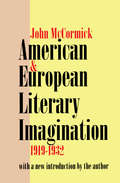- Table View
- List View
American Women's History: A New Narrative History (Women, Gender, And Sexuality In American History Ser. #1)
by Vanessa M. Holden Maeve Kane Melissa E. BlairOffers a nuanced account of the multiple aspects of women’s lives and their roles in American society American Women's History presents a comprehensive survey of women's experience in the U.S. and North America from pre-European contact to the present. Centering women of color and incorporating issues of sexuality and gender, this student-friendly textbook draws from cutting-edge scholarship to provide a more inclusive and complicated perspective on the conventional narrative of U.S. women’s history. Throughout the text, the authors highlight diverse voices such as Matoaka (Pocahontas), Hilletie van Olinda, Margaret Sanger, and Annelle Ponder. Arranged chronologically, American Women's History explores the major turning points in American women’s history while exploring various contexts surrounding race, work, politics, activism, and the construction of self. Concise chapters cover a uniquely wide range of topics, such as the roles of Indigenous women in North American cultures, the ways women participated in the American Revolution, the lives of women of color in the antebellum South and their experiences with slave resistance and rebellion, the radical transformation brought on by Black women during Reconstruction, the activism of women before and after suffrage was won, and more. Discusses how Indigenous women navigated cross-cultural contact and resisted assimilation efforts after the arrival of Europeans Considers the construction of Black female bodies and the implications of the slave trade in the Americas Addresses the cultural shifts, demographic changes, and women’s rights movements of the early twentieth century Highlights women’s participation in movements for civil rights, workplace justice, and equal educational opportunities Explores the feminist movement and its accomplishments, the rise of anti-feminism, and women’s influence on the modern political landscapeDesigned for both one- and two-semester U.S. history courses, American Women's History is an ideal resource for instructors looking for a streamlined textbook that will complement existing primary sources that work well in their classes. Due to its focus on women of color, it is particularly valuable for community colleges and other institutions with diverse student populations.
American Women's Regionalist Fiction: Mapping the Gothic (Palgrave Gothic)
by Monika Elbert Rita BodeAmerican Women’s Regionalist Fiction: Mapping the Gothic seeks to redress the monolithic vision of American Gothic by analyzing the various sectional or regional attempts to Gothicize what is most claustrophobic or peculiar about local history. Since women writers were often relegated to inferior status, it is especially compelling to look at women from the Gothic perspective. The regionalist Gothic develops along the line of difference and not unity—thus emphasizing regional peculiarities or a sense of superiority in terms of regional history, natural landscapes, immigrant customs, folk tales, or idiosyncratic ways. The essays study the uncanny or the haunting quality of “the commonplace,” as Hawthorne would have it in his introduction to The House of the Seven Gables, in regionalist Gothic fiction by a wide range of women writers between ca. 1850 and 1930. This collection seeks to examine how/if the regionalist perspective is small, limited, and stultifying and leads to Gothic moments, or whether the intersection between local and national leads to a clash that is jarring and Gothic in nature.
American Women's Suffrage: Voices from the Long Struggle for the Vote 1776-1965 (The Library of America)
In their own voices, the full story of the women and men who struggled to make American democracy wholeWith a record number of female candidates in the 2020 election and women's rights an increasingly urgent topic in the news, it's crucial that we understand the history that got us where we are now. For the first time, here is the full, definitive story of the movement for voting rights for American women, of every race, told through the voices of the women and men who lived it. Here are the most recognizable figures in the campaign for women's suffrage, like Elizabeth Cady Stanton and Susan B. Anthony, but also the black, Chinese, and American Indian women and men who were not only essential to the movement but expanded its directions and aims. Here, too, are the anti-suffragists who worried about where the country would head if the right to vote were universal. Expertly curated and introduced by scholar Susan Ware, each piece is prefaced by a headnote so that together these 100 selections by over 80 writers tell the full history of the movement--from Abigail Adams to the 1848 Declaration of Sentiments to the ratification of the Nineteenth Amendment in 1920 and the limiting of suffrage under Jim Crow. Importantly, it carries the story to 1965, and the passage of the Voting and Civil Rights Acts, which finally secured suffrage for all American women. Includes writings by Ida B. Wells, Mabel Lee, Margaret Fuller, Sojourner Truth, Frances Ellen Watkins Harper, Frederick Douglass, presidents Grover Cleveland on the anti-suffrage side and Woodrow Wilson urging passage of the Nineteenth Amendment as a wartime measure, Jane Addams, and Charlotte Perkins Gilman, among many others.
American Women: A Concise History
by Susan WareAmerican Women: A Concise History offers the most accessible and engaging introduction to the history of American women” --Provided by publisher.
American Women’s Ghost Stories in the Gilded Age
by Dara DowneyThis book shows just how closely late nineteenth-century American women's ghost stories engaged with objects such as photographs, mourning paraphernalia, wallpaper and humble domestic furniture. Featuring uncanny tales from the big city to the small town and the empty prairie, it offers a new perspective on an old genre.
American Workers, American Unions
by Robert H. Zieger Timothy J. Minchin Gilbert J. GallHighly acclaimed and widely read since its first publication in 1986, American Workers, American Unions provides a concise and compelling history of American workers and their unions in the twentieth century and the first decade of the twenty-first. Taking into account recent important work on the 1970s and the Reagan revolution, the fourth edition newly considers the stagflation issue, the rise of globalization and big box retailing, the failure of Congress to pass legislation supporting the right of public employees to collective bargaining, the defeat in Congress of legislation to revise the National Labor Relations Act, the emasculation of the Humphrey-Hawkins Act, and the changing dynamics of blue-collar politics. In addition to important new information on the 1970s and 1980s, the fourth edition contains a completely new final chapter. Largely written by Timothy J. Minchin, this chapter provides a rare survey of American workers and their unions between 9/11 and the 2012 presidential election. Gilbert J. Gall presents new information on government workers and their recent battles to defend workplace rights.
American Workers, American Unions: The Twentieth and Early Twenty-First Centuries (The American Moment)
by Robert H. Zieger Timothy J. Minchin Gilbert J. GallAn update to the classic history of labor and unions for a post-9/11 world.Highly acclaimed and widely read since its first publication in 1986, American Workers, American Unions provides a concise and compelling history of American workers and their unions in the twentieth century and the first decade of the twenty-first. Taking into account recent important work on the 1970s and the Reagan revolution, the fourth edition newly considers the stagflation issue, the rise of globalization and big box retailing, the failure of Congress to pass legislation supporting the right of public employees to collective bargaining, the defeat in Congress of legislation to revise the National Labor Relations Act, the emasculation of the Humphrey-Hawkins Act, and the changing dynamics of blue-collar politics. In addition to important new information on the 1970s and 1980s, the fourth edition contains a completely new final chapter. Largely written by Timothy J. Minchin, this chapter provides a rare survey of American workers and their unions between 9/11 and the 2012 presidential election. Gilbert J. Gall presents new information on government workers and their recent battles to defend workplace rights.
American Workers, Colonial Power: Philippine Seattle and the Transpacific West, 1919-1941
by Dorothy B. Fujita-RonyDorothy B. Fujita-Rony traces the evolution of Seattle as a major site for Philippine immigration between World Wars I and II and examines the dynamics of the community through the frameworks of race, place, gender, and class.
American World Literature: An Introduction (Textxet: Studies In Comparative Literature Ser. #47)
by Paul GilesA scholarly review of American world literature from early times to the postmodernist era American World Literature: An Introduction explores how the subject of American Literature has evolved from a national into a global phenomenon. As the author, Paul Giles – a noted expert on the topic – explains, today American Literature is understood as engaging with the wider world rather than merely with local or national circumstances. The book offers an examination of these changing conceptions of representation in both a critical and an historical context. The author examines how the perception of American culture has changed significantly over time and how this has been an object of widespread social and political debate. From examples of early American literature to postmodernism, the book charts ways in which the academic subject areas of American Literature and World Literature have converged – and diverged – over the past generations. Written for students of American literature at both undergraduate and postgraduate levels and in all areas of historical specialization, American World Literature offers an authoritative guide to global phenomena of American World literature and how this subject has undergone crucial changes in perception over the past thirty years.
American Writers In Europe
by Ferdâ AsyaAmerican Writers in Europe explores the impartial critical outlook that American writers acquired in different parts of Europe, from 1850 to the present, and used as a lens to view Europe and America. Focusing on some less familiar writers, it reveals intriguing aspects of the lives and works of American writers than those of the customarily anthologized expatriates. Offering a broad range of American experiences in Europe in an extensive span of time, the volume widens the history of the transatlantic cultural and literary dialogue between America and Europe.
American Writers and the Approach of World War II, 1935-1941
by Ichiro TakayoshiIchiro Takayoshi's book argues that World War II transformed American literary culture. From the mid-1930s to the American entry into World War II in 1941, preeminent figures from Ernest Hemingway to Reinhold Neibuhr responded to the turn of the public's interest from the economic depression at home to the menace of totalitarian systems abroad by producing novels, short stories, plays, poems, and cultural criticism in which they prophesied the coming of a second world war and explored how America could prepare for it. The variety of competing answers offered a rich legacy of idioms, symbols, and standard arguments that was destined to license America's promotion of its values and interests around the world for the rest of the twentieth century. Ambitious in scope and addressing an enormous range of writers, thinkers, and artists, this book is the first to establish the outlines of American culture during this pivotal period.
American Writers and the Picturesque Tour: The Search for National Identity, 1790-1860 (Garland Studies in 19th Century American Literature #Vol. 7)
by Beth L. LueckExplores a beloved genreEven before the age of the Romantics, travel literature was a favorite genre of English and American writers and readers. After the War of 1812, Americans' passion for scenic beauty inspired them to take the picturesque tour of America as well as going to Europe for the requisite Grand Tour. The written American version of the popular British tour in various guidebooks helped shape the literature of the new nation as nearly every major writer of the first half of the 19th century contributed to it from Poe, who provided several comic pieces, and Irving to Thoreau, for whom the tour symbolized moral and spiritual growth, and Margaret Fuller.Offers new perspectivesAmerican writers adapted the picturesque to express their nationalistic sentiments; picturesque discourse offered a flexible series of conventions that enable writers to celebrate the places, people, and legends that set America apart. This volume demonstrates the vital role of this genre in the formation of national literary taste and national culture and offers fresh and exciting perspectives on the topic. Includes index. Also includes maps.
American Youth Gangs at the Millennium
by Finn-Aage Esbensen Stephen G. Tibbetts Larry GainesFor generations, scholars, law enforcement personnel, politicians, and the media have tried to understand and explain youth gangs and violence. This insightful collection contains the work of leading scholars, integrating previously published articles with new material to provide the most comprehensive information about the status of American youth gangs. The contributors attempt to answer crucial questions for understanding gangs: What is a gang? What are the risk factors associated with joining a gang? What is the nature of gang violence? How involved are girls in gangs and gang violence? The contributors¿ multifaceted approach to these questions and their ensuing discussions describe the varied and individual responses to gang violence. The topics are grouped in four sections: The first section explores the issues and ramifications of current terminology and survey information. In the second section, nontraditional gangs, such as female gangs and hybrid gangs, are discussed. The third section attempts to examine gang activities objectively and place them in a proper perspective. The final section looks at historical and current response techniques to youth gangs, such as suppression, prevention, and legal injunctions.
American Youth: A Novel
by Phil LamarcheIn this taut and powerful novel, a young teenager is confronted by a terrible moral dilemma following a firearms accident at his home. Coerced by his mother to lie about his role in the incident, he finds he has nonetheless earned the admiration of a sinister group of boys at his school - calling themselves 'American Youth', they subscribe to a twisted notion of traditional, puritanical values. As he gets sucked into their orbit, and entangled with the girlfriend of the group's leader, he struggles to hold on to a sense of right and wrong. Set in a New England town riven by social and ideological tensions - as newcomers encroach on an old rural culture - this is a classic portrait of a boy's rites of passage in an America ill at ease with itself.
American Zealots: Inside Right-Wing Domestic Terrorism (Columbia Studies in Terrorism and Irregular Warfare)
by Arie PerligerIn an unsettling time in American history, the outbreak of right-wing violence is among the most disturbing developments. In recent years, attacks originating from the far right of American politics have targeted religious and ethnic minorities, with a series of antigovernment militants, religious extremists, and lone-wolf mass shooters inspired by right-wing ideologies. The need to understand the nature and danger of far-right violence is greater than ever.In American Zealots, Arie Perliger provides a wide-ranging and rigorously researched overview of right-wing domestic terrorism. He analyzes its historical roots, characteristics, tactics, rhetoric, and organization, assessing the current and future trajectory of the use of violence by the far right. Perliger draws on a comprehensive dataset of more than 5,000 attacks and their perpetrators from 1990 through 2017 in order to explore key trends in American right-wing terrorism. He describes the entire ideological spectrum of the American far right, including today’s white supremacists, antigovernment groups, and antiabortion fundamentalists, as well as the histories of the KKK, skinheads, and neo-Nazis. Based on these findings, Perliger suggests counterterrorism policies that can respond effectively to the far-right threat. A groundbreaking examination of violence spawned from right-wing ideologies, American Zealots is essential reading for everyone seeking to understand the transformation of domestic terrorism.
American Zion: A New History of Mormonism
by Benjamin E. ParkNew Yorker — "The Best Books We’ve Read in 2024 So Far" The first major history of Mormonism in a decade, drawing on newly available sources to reveal a profoundly divided faith that has nevertheless shaped the nation. The Church of Jesus Christ of Latter-day Saints was founded by Joseph Smith in 1830 in the so-called “burned-over district” of upstate New York, which was producing seers and prophets daily. Most of the new creeds flamed out; Smith’s would endure, becoming the most significant homegrown religion in American history. How Mormonism succeeded is the story told by historian Benjamin E. Park in American Zion. Drawing on sources that have become available only in the last two decades, Park presents a fresh, sweeping account of the Latter-day Saints: from the flight to Utah Territory in 1847 to the public renunciation of polygamy in 1890; from the Mormon leadership’s forging of an alliance with the Republican Party in the wake of the New Deal to the “Mormon moment” of 2012, which saw the premiere of The Book of Mormon musical and the presidential candidacy of Mitt Romney; and beyond. In the twentieth century, Park shows, Mormons began to move ever closer to the center of American life, shaping culture, politics, and law along the way. But Park’s epic isn’t rooted in triumphalism. It turns out that the image of complete obedience to a single, earthly prophet—an image spread by Mormons and non-Mormons alike—is misleading. In fact, Mormonism has always been defined by internal conflict. Joseph Smith’s wife, Emma, inaugurated a legacy of feminist agitation over gender roles. Black believers petitioned for belonging even after a racial policy was instituted in the 1850s that barred them from priesthood ordination and temple ordinances (a restriction that remained in place until 1978). Indigenous and Hispanic saints—the latter represent a large portion of new converts today—have likewise labored to exist within a community that long called them “Lamanites,” a term that reflected White-centered theologies. Today, battles over sexuality and gender have riven the Church anew, as gay and trans saints have launched their own fight for acceptance. A definitive, character-driven work of history, American Zion is essential to any understanding of the Mormon past, present, and future. But its lessons extend beyond the faith: as Park puts it, the Mormon story is the American story.
American Zion: Cliven Bundy, God And Public Lands In The West
by Betsy Gaines Quammen"A deep, fascinating dive into a uniquely American brand of religious zealotry that poses a grave threat to our national parks, wilderness areas, wildlife sanctuaries, and other public lands. It also happens to be a delight to read." —JON KRAKAUER American Zion is the story of the Bundy family, famous for their armed conflicts in the West. With an antagonism that goes back to the very first Mormons who fled the Midwest for the Great Basin, they hold a sense of entitlement that confronts both law and democracy. Today their cowboy confrontations threaten public lands, wild species, and American heritage. BETSY GAINES QUAMMEN is a historian and conservationist. She received a doctorate in Environmental History from Montana State University in 2017, her dissertation focusing on Mormon settlement and public land conflicts. After college in Colorado, caretaking for a bed and breakfast in Mosier, Oregon, and serving breakfasts at a cafe in Kanab, Utah, Betsy has settled in Bozeman, Montana, where she now lives with her husband, writer David Quammen, three huge dogs, an overweight cat, and a pretty big python named Boots.
American Zionism: American Jewish History (American Jewish History)
by Jeffrey S. GurockFirst Published in 1998. Routledge is an imprint of Taylor & Francis, an informa company.
American Zoo
by David GrazianOrangutans swing from Kevlar-lined fire hoses. Giraffes feast on celebratory birthday cakes topped with carrots instead of candles. Hi-tech dinosaur robots growl among steel trees, while owls watch animated cartoons on old television sets. In American Zoo, sociologist David Grazian takes us on a safari through the contemporary zoo, alive with its many contradictions and strange wonders. Trading in his tweed jacket for a zoo uniform and a pair of muddy work boots, Grazian introduces us to zookeepers and animal rights activists, parents and toddlers, and the other human primates that make up the zoo's social world. He shows that in a major shift away from their unfortunate pasts, American zoos today emphasize naturalistic exhibits teeming with lush and immersive landscapes, breeding programs for endangered animals, and enrichment activities for their captive creatures. In doing so, zoos blur the imaginary boundaries we regularly use to separate culture from nature, humans from animals, and civilization from the wild. At the same time, zoos manage a wilderness of competing priorities--animal care, education, scientific research, and recreation--all while attempting to serve as centers for conservation in the wake of the current environmental and climate-change crisis. The world of the zoo reflects how we project our own prejudices and desires onto the animal kingdom, and invest nature with meaning and sentiment.A revealing portrayal of comic animals, delighted children, and feisty zookeepers, American Zoo is a remarkable close-up exploration of a classic cultural attraction.
American and Australasian Marsupials: An Evolutionary, Biogeographical, and Ecological Approach
by Nilton C. Cáceres Christopher R. DickmanThis book focuses on the ecology, evolution, biogeography, systematics and taxonomy of New World and Australasian marsupials, greatly expanding the current knowledge base. There are roughly 140 species of New World marsupials, of which the opossum is the best known. Thanks to recent research, there is now an increasing amount of understanding about their evolution, biogeography, systematics, ecology, and conservation in the Americas, especially in South America. There are also some 270 marsupial species in the Australasian region, many of which have been subject to research only in recent years. Based on this information and the authors’ extensive research, this book provides comprehensive insights into the world's marsupials. It will appeal to academics and specialized researchers, students of zoology, paleontology, evolutionary biology, ecology, physiology and conservation, as well as interested non-experts.
American and British English: Divided by a Common Language?
by Paul BakerIs British English becoming more like American English? If so, why, and in what ways? This book compares examples of American and British language data from the 1930s, 1960s, 1990s and 2000s, to track the most important ways that both varieties are changing over time, and compares the extent to which they are following similar paths using a mixture of computer and human analysis. The analysis is carried out across several levels, including spelling differences (such as colour vs color), vocabulary (truck vs lorry), and a range of morphological, grammatical, semantic and pragmatic features. Baker explores the changing aspects of American and British society which help to explain the findings.
American and British Soft Power in Iran, 1953-1960: A 'Special Relationship'?
by Darius WainwrightThis book offers a distinctive approach to understanding Anglo-American relations with Iran in the early Cold War. It establishes how the United Kingdom and United States used soft power between 1953 and 1960 to combat communism and promote their respective ways of life in Iran. It identifies their motives, the types of initiatives employed, and the extent to which they perceived their policies to be a success. It is a historical case study through which wider conclusions regarding UK and US foreign policy can be drawn. As well as illustrating the competitive tensions within the Anglo-American 'special relationship', it highlights the role of individuals in the making and shaping of diplomatic endeavours. More broadly, the analysis of UK and US interactions in Iran through the prism of soft power underlines that there was more to both countries’ Cold War foreign policies than the containment of communism.
American and Canadian Counterinsurgency Strategies in Afghanistan (Canada and International Affairs)
by Federmán RodríguezThe book aims to explain the factors that brought about a high degree of similarity between American and Canadian foreign and security policies during the Afghanistan intervention. Specifically, it seeks to explain why, despite their different positions in the international distribution of power, the United States and Canada embraced similar counterinsurgency (COIN) strategies from 2005/2006 to 2011. During this time, the United States and Canada fought against insurgent groups, sought to maintain stabilized areas by mentoring Afghan forces, and invested in infrastructure and governance. These goals, which corresponded to the ‘clear,’ ‘hold,’ and ‘build’ COIN components, entailed sending troops and civilian officials to a war zone and committing financial resources.
American and Chinese-Language Cinemas: Examining Cultural Flows (Routledge Advances in Film Studies)
by Lisa Funnell Man-Fung YipCritics frequently describe the influence of "America," through Hollywood and other cultural industries, as a form of cultural imperialism. This unidirectional model of interaction does not address, however, the counter-flows of Chinese-language films into the American film market or the influence of Chinese filmmakers, film stars, and aesthetics in Hollywood. The aim of this collection is to (re)consider the complex dynamics of transnational cultural flows between American and Chinese-language film industries. The goal is to bring a more historical perspective to the subject, focusing as much on the Hollywood influence on early Shanghai or postwar Hong Kong films as on the intensifying flows between American and Chinese-language cinemas in recent decades. Contributors emphasize the processes of appropriation and reception involved in transnational cultural practices, examining film production, distribution, and reception.
American and European Literary Imagination
by John McCormickWestern culture is composed of a subtle and complex mixture of influences: religious, philosophical, linguistic, political, social, and sociological. American culture is a particular strain, but unless European antecedents and contemporary leanings are duly noted, any resulting history is predestined to provincialism and distortion. In his account of American literature during the period 1919 to 1932, McCormick deals with the extraordinary work of artists who wrested imaginative order from a world in which the abyss was never out of sight.McCormick's volume is intended as a critical, rather than encyclopedic history of literature on both sides of the Atlantic between the end of World War I and the political and social crises that arose in the 1930s. Although he emphasizes American writers, the emergence of a vital and distinctly modern American literature is located in the cultural encounter with Europe and the rejection of national bias by the major figures of the period.McCormick deals with Gertrude Stein and the mythology of the "lost generation," the tensions and ambivalences of traditionalism and modernity in the work of Sherwood Anderson and F. Scott Fitzgerald, the effect and qualities of Hemingway's style as compared to that of Henry de Montherlant, and the provincial iconoclasm of Sinclair Lewis juxtaposed with the more telling satire of Italo Svevo. The formal innovations in the work of John Dos Passos, E.E. Cummings, and William Faulkner, the poetic revolution against cultural parochialism and genteel romanticism is given extensive consideration with regard to the work of T.S. Eliot, Ezra Pound, Wallace Stevens, William Carlos Williams, and Marianne Moore are also discussed. The concluding chapters discuss literary and social criticism and assess the influence of psychoanalysis, philosophical pragmatism, and radical historiography on the intellectual climate of the period.Teachers and students in English and American Literature, American History, and Comparative Literature, and the general reader interested in the writing of the period, may gain new insights from these valuations, devaluations, and re-evaluations.
